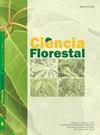不同种植密度下桉树和伞藓无性系木材的理化性质
IF 0.5
4区 农林科学
Q4 FORESTRY
引用次数: 0
摘要
本研究旨在评价桉树(Eucalyptus spp) 2个商业杂交无性系和山茱萸(Corymbia spp) 2个杂交无性系在3种不同种植间距下24月龄木材的一些技术特性。每个无性系在每个间距取样4棵树,以测定以下木材特性:基本密度、总热值、能量密度和纤维素、半纤维素、木质素、灰分和碳含量。无性系x间距互作对木材的基本密度、能量密度、木质素和纤维素含量均有显著影响。桉树的木质素和纤维素含量最高,杉木杂交无性系的木材基本密度和能量密度最高,其中以C3无性系的平均值最高。对于木材中半纤维素和灰分的含量,观察到无性系效应和间距效应。对木材碳含量和总热值的影响,无论是无性系、间距还是两者的交互作用均不显著。结果表明,所评价的遗传材料之间的性状与所测的种植间距有关,存在差异。应当指出,选择最好的遗传材料应根据木材的技术特性,但也应评价与该树种良好造林有关的森林生产力。本文章由计算机程序翻译,如有差异,请以英文原文为准。
Physical and chemical properties of wood from Eucalyptus and Corymbia clones in different planting densities
The present work aimed to evaluate some technological characteristics of the wood of two commercial hybrid clones of Eucalyptus spp and two hybrid clones of Corymbia spp, implanted in three different planting spacings, at 24 months of age. Four trees per clone were sampled at each spacing to determine the following wood characteristics: basic density, gross calorific value, energy density and cellulose, hemicellulose, lignin, ash and carbon contents. There was a significant effect of the clone x spacing interaction for the basic density, energy density, lignin and cellulose contents of the wood. Eucalyptus showed the highest levels of lignin and cellulose, and hybrid clones of Corymbia the highest values of basic density and energy density of wood, with emphasis on clone C3, where the highest averages of the study were verified. For the levels of hemicelluloses and ash in the wood, the clone effect and spacing effect were observed. As for the carbon content and the gross calorific value in the wood, there was no significant effect, either from the clone, the spacing or the interaction of these two factors. The results show that there is variability in the characteristics between the genetic materials evaluated and in relation to the planting spacing tested. It should be noted that the choice of the best genetic material should be based on the technological characteristics of the wood, but also the forest productivity associated with good silviculture of the species should be evaluated.
求助全文
通过发布文献求助,成功后即可免费获取论文全文。
去求助
来源期刊

Ciencia Florestal
农林科学-林学
CiteScore
0.80
自引率
0.00%
发文量
85
审稿时长
18-36 weeks
期刊介绍:
The journal Forest Science was established in 1991 with the goal of being a vehicle for dissemination which are published works tércnico-scientific forest-related, the following bodies crowded the Centro de Ciências Rurais of Universidade Federal de Santa Maria:
- Centro de Pesquisas Florestais - CEPEF
- Programa de Pós-graduação em Engenharia Florestal - PPGEF
- Departamento de Ciências Florestais - DCFL
MISSION:
Publish scientific papers, technical notes, and literature reviews related to the area of forest sciences.
 求助内容:
求助内容: 应助结果提醒方式:
应助结果提醒方式:


